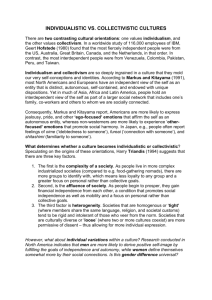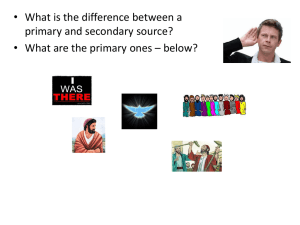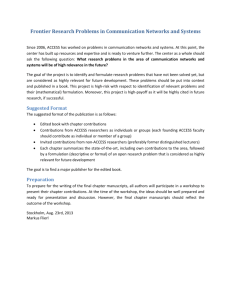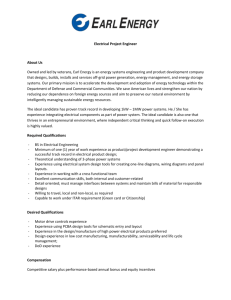707.009 Foundations of Knowledge Management „Theoretical
advertisement
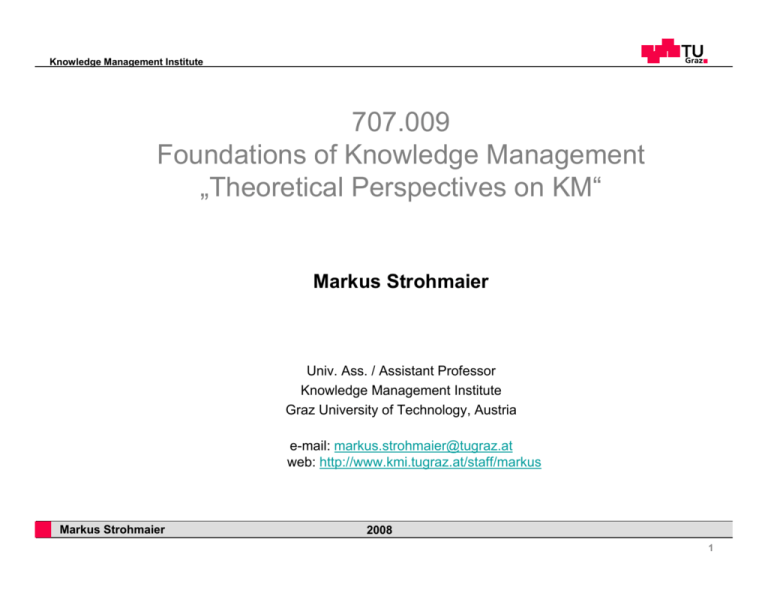
Knowledge Management Institute 707.009 Foundations of Knowledge Management „Theoretical Perspectives on KM“ Markus Strohmaier Univ. Ass. / Assistant Professor Knowledge Management Institute Graz University of Technology, Austria e-mail: markus.strohmaier@tugraz.at web: http://www.kmi.tugraz.at/staff/markus Markus Strohmaier 2008 1 Knowledge Management Institute Overview Agenda • Different Roles in Knowledge Management • Perspectives on Knowledge Management Markus Strohmaier 2008 2 Knowledge Management Institute Problem for today‘s lecture • How to start a Knowledge Management Initiative in Organizations • What are possible starting points? • What are possible strategies / techniques? • What are the implications of choosing one over the other? Î Theory of KM in Organizational Contexts Markus Strohmaier 2008 3 Knowledge Management Institute Roles in Knowledge Management and selected KM Support Categories [Strohmaier2004] Based on [Schreiber et al. 02] Knowledge management interventions are typically organised as a project [Maier02] Strategic Support Methodological Support Cognitive Support Methodological Support Markus Strohmaier 2008 4 Knowledge Management Institute Knowledge Infrastructures • • Knowledge Infrastructures are an Enabler for Knowledge Management [Siv01]. Knowledge Infrastructures aim to support and improve the work of knowledge workers [DJB95]. Culture, CoP, Learning, Mentoring, Experience Mgt., ... Î 3 Main Dimensions: Human Systems Intranets, KMSystems, Portals, CSCW, ... Business Processes, Roles, Projects, Institutions, ... Technological Systems Markus Strohmaier Organizational Systems 2008 5 Knowledge Management Institute The Knowledge Manager The knowledge manager (or CKO - Chief Knowledge Officer) is regarded to be highest ranked role in knowledge management [Mai02, p.143]. In this steering position, his main responsibility is to develop and implement a knowledge management strategy that is aligned to an organization’s business strategy [Leh00, p. 226], [SAA+02, p. 22], [MHV03, p.107]. He initiates and coordinates knowledge management projects and monitors the results in terms of their contribution to the KM strategy as well as in terms of achieving economic benefits. In larger organizations, this role is typically performed by one CKO who supervises various knowledge managers in his business unit [Mai02]. plicitly executed by Markus Strohmaier Is often im an some other role in organization 2008 6 Knowledge Management Institute The Knowledge Manager – Strategic Considerations Example Markus Strohmaier 2008 7 Knowledge Management Institute The Project Manager The project manager (or knowledge project manager [MHV03]) is in charge of running knowledge management projects [SAA+02, p. 22]. He focuses on aspects related to project management such as the development of project goals and plans or the coordination of project team members [MHV03, p. 107]. The project manager takes a business perspective on the project to ensure that the project goals are met in time and within the provided resources. He is also responsible for dealing with project monitoring, controlling and/or marketing. Markus Strohmaier 2008 8 Knowledge Management Institute The Knowledge Worker Knowledge workers are the primary target group of a knowledge infrastructure development project (also see [Mai02, p. 150]). Knowledge workers are regarded to execute knowledge intensive work within or outside of business processes. They implicitly or explicitly generate, store, transfer and apply knowledge. Knowledge Intensity: •Learning time •Half life •Decision scope •Agent impact Thus, the role of a knowledge worker is broader than that of a knowledge user [SAA+02, p. 22] (additional focus on knowledge generation, storage Complexity: •Process steps and transfer), and •Involved agents •Interdependency is not related to the role of a knowledge management •Process dynamic worker [MHV03, p. 108], who is a trained person dedicated to perform operational knowledge management activities such as categorizing or structuring knowledge bases. Markus Strohmaier Eppler 2002 2008 9 Knowledge Management Institute The Knowledge Analyst The knowledge analyst is responsible for analyzing organizational knowledge work executed by knowledge workers. Similar to the role system analyst [You89, p. 56], he investigates a complex object system (organizational knowledge work) and generates models that illustrate core aspects of the system under investigation. In doing so, the knowledge analyst provides specific knowledge views on the system that represent a fundament for subsequent activities of knowledge infrastructure designers. Markus Strohmaier 2008 11 Knowledge Management Institute The Knowledge Analyst – Examplary Models [Gronau 2006] [Strohmaier 2006] Markus Strohmaier 2008 12 Knowledge Management Institute The Knowledge Infrastructure Designer The knowledge infrastructure designer is responsible for transforming the developed models of organizational work into a design that describes a supportive environment for knowledge workers (in analogy to [You89, p. 57]). He develops a design of the system, which is the basis for implementation. The knowledge infrastructure designer (or an implementation team) implements the final design. He also accompanies the validation of the solution with knowledge workers. Markus Strohmaier 2008 13 Knowledge Management Institute The Knowledge Infrastructure Designer – High Level Design Example Role Portal HR Generation, Storage Role Portal TL Transfer Role Portal VPE other Portals other Sources Application Knowledge Processes Markus Strohmaier 2008 14 Knowledge Management Institute Schools of KM [Earl 2001] Different Conceptualizations of KM in Organizations Markus Strohmaier 2008 15 Knowledge Management Institute Schools of KM [Earl 2001] Choice in „What to do“ and „How to do it“ Unit of Analysis Markus Strohmaier 2008 16 Knowledge Management Institute Schools of KM [Earl 2001] • • • • These perspectives are not mutually exclusive. These perspectives are not complete. No focus on one single type of knowledge Perspectives span different levels (data – information – knowledge) • Technocratic perspective – Support for knowledge workers, conditioning knowledge workers • Economic perspective – Creation of revenue from the exploitation knowledge and intellectual capital • Behavioural perspective – Stimulating a knowledge culture, social aspects Markus Strohmaier broad How do these te to KM la e r s e ri o g te a c roles? 2008 17 Knowledge Management Institute Systems Perspective [Earl 2001] • • • • • • ataWhat concept (d ledge) w o n -k n o ti a rm fo in ately would predomin roach? apply to this app Capture knowledge in knowledge bases Make individual knowledge explicit and available to the organization Codifying experience and expertise for others knowledge bases tend to be domain-specific, supporting and improving specific knowledge-intensive work tasks and particular sorts of decision-making Examples can be found in engineering design and maintenance For example, Airbus Industries create CD-ROMs of airplane maintenance technical expertise—maintenance manuals—to distribute to technical staff in airports worldwide. The essence is that authorized technical specifications and repair and maintenance procedures are distributed in a controlled and updateable manner. Markus Strohmaier 2008 18 Knowledge Management Institute Systems Perspective [Earl 2001] • • • Knowledge can not only be derived from data, but from experience and expertise This requires efforts in validation Underlying philosphy: externalization Implications: • IT is essential: without IT, this approach would not be feasible • Motivation and incentives are essential • IT which captures, stores, organizes, and displays knowledge provided by knowledge workers is a critical enabler Markus Strohmaier 2008 19 Knowledge Management Institute Systems Perspective Markus Strohmaier 2008 20 Knowledge Management Institute Cartographic Perspective [Earl 2001] • • • Focus on mapping organizational knowledge „Who knows what“: Increase transparency about who in an organization knows what Via, e.g., the construction of knowledge directories or „yellow pages“ • • Not so much repositories, but gateways to knowledge Importance of orientational/navigational knowledge • Example: Bain and Company Implementation of a „peoplefinder“ database Emphasis on connecting people and communication instruments such as e-mail, video-conferencing or face-to-face meetings Markus Strohmaier wledge What type of kno ch does this approa focus on? 2008 21 Knowledge Management Institute Cartographic Perspective [Earl 2001] • In contrast to the system‘s perspective, focus is on incentivizing exchange of knowledge with others rather than giving knowledge to a system • Quality and Up-to-dateness of competency / skills profiles / culture of knowledge sharing are critical to this approach • Based on the assumption that updating profiles is cheaper than mapping what the organization knows in different domains • The main contribution of IT is to connect people via e.g. intranets, synchronous and asynchronous communication instruments And to help them locate knowledge sources • Markus Strohmaier 2008 22 Knowledge Management Institute Knowledge Maps • Knowledge Maps (oder auch Wissenskarten) sind graphische Verzeichnisse über das Wissen einer Organisation. Dabei können Wissensträger, Wissensquellen, Wissensstrukturen, Wissensbestände, Wissenskopplungen oder Wissensanwendungen dokumentiert werden. • Vorteile die sich dadurch ergeben sind: • Transparenzerhöhung (und damit verbunden ein verbessertes Verständnis von Abläufen, Prozessen und Zuständigkeiten) Erleichterte Lokalisierung von Wissen Erleichterte Erkennung von Wissensdefiziten bzw. überschüssen Erleichterte Einordnung von neuem Wissen • • • Markus Strohmaier 2008 23 Knowledge Management Institute Wissenslandkarte [Hackl 2005] Markus Strohmaier 2008 24 Knowledge Management Institute Wissenslandkarte [Hackl 2005] Markus Strohmaier 2008 25 Knowledge Management Institute Case Studies Hansen 1999 Markus Strohmaier 2008 26 Knowledge Management Institute Schools of KM [Earl 2001] Markus Strohmaier 2008 27 Knowledge Management Institute Engineering PerspectiveWhat type of knowledge ch [Earl 2001] does this approa focus on? • Assumption: Performance of business processes can be enhanced by providing operating personnel with knowledge relevant to their tasks • Critical success factors both knowledge and information needs to be provided by IT „Give knowledge workers the knowledge and information to do the job“ • • Essential contribution of IT: the provision of shared databases across tasks, processes, and organizational levels. Markus Strohmaier 2008 28 Knowledge Management Institute Engineering Perspective [Earl 2001] • Example HP: Identifying key knowledge areas within divisions in order to capture and make available known knowledge to support knowledge workers Mapping knowledge links between divisions so that ideas may be shared among different groups of knowledge workers Markus Strohmaier 2008 29 Knowledge Management Institute Engineering Perspective Markus Strohmaier 2008 30 Knowledge Management Institute Schools of KM [Earl 2001] Markus Strohmaier 2008 31 Knowledge Management Institute Commercial PerspectiveWhat type of knowledge ch does this approa [Earl 2001] s on? focu • • Focus on protecting and exploiting a company‘s knowledge or intellectual assets to produce revenue streams Including intellectual assets such as – – – – • • • Patents (Patent management)) Trade marks Managing knowledge as an „asset“ Copyrights know-how Most concerned with exploitation, and least concerned with exploration Intellectual capital often characterized as the difference between book and market value Success factor: – Organizational roles that aggressively manage knowledge property – Techniques and processes to measure and manage IC as a routinized process Markus Strohmaier 2008 32 Knowledge Management Institute Commercial Perspective [Earl 2001] • Example: Dow Chemical Company • Turned the management of its patent portfolio into an active management process Patent department was incurring costs of $30 mio per annum, and generated revenues of only $25 mio. A patent can cost up to $250.000 over ist entire lifetime Critical reflection on patents that Dow was holding and considering • • • – Abandoning, donating, licensing or selling them. • Over $40 mio savings in 18 months Markus Strohmaier 2008 33 Knowledge Management Institute Example IC Report http://www.akwissensbilanz.org/ Markus Strohmaier 2008 34 Knowledge Management Institute Schools of KM [Earl 2001] Markus Strohmaier 2008 35 Knowledge Management Institute Organizational Perspective wledge What type of kno ch [Earl 2001] does this approa focus on? • • • • • • Focuses on the use of organizational structures or networks to share or pool knowledge Knowledge communities, the archtypal organizational arrangement of a group of people with a common interest, problem or experience Designed and maintained for a business purpose Inter- or Intraorganizational Bringing together knowledge and knowers Combine both systems- and cartographic perspective A new role: knowledge intermediary • Behavioural, because • – Knowledge is exchanged in a nonroutine, personal and unstructured way Markus Strohmaier 2008 36 Knowledge Management Institute Organizational Perspective [Earl 2001] • Example: Shell: Three different types of „forums“ nology, h c e t e ~ sam ses o p r u p t differen – Best Practice Forum: Most codified and structured, Maintained and validated by the community – Discussion Forum: Least codified, around a topic of common interest – Task Forum: intermediate level of codification, centred around a community of poeple brought together to solve a significant challenge, e.g. turning around a business • Each forum has a moderator, a „human hub“ Role of IT: • Knowledge is often captured on video • Knowledge base does not contain everything that could be externalized, but integrates cartographic aspects • Videoconferencing • Community support Markus Strohmaier 2008 37 Knowledge Management Institute Organizational Perspective [Earl 2001] • Critical success factors: – Culture of knowledge sharing and networking – „Human hubs“ are essential to increase connectivity between knowledge workers Markus Strohmaier 2008 38 Knowledge Management Institute Schools of KM [Earl 2001] Markus Strohmaier 2008 39 Knowledge Management Institute Spatial Perspective [Earl 2001] • • • • • • ataWhat concept (d ledge) information-know ately would predomin roach? apply to this app More of a philosophy Focuses on the use of space – or spatial design – to facilitate knowledge exchange Examples: the water cooler, coffee kitchen Basic assumption: Spatial layout of an organization (how teams are grouped in offices, how a building provides for serendipitous encounters) has an influence on the way knowledge is being shared Tacit knowledge is most likely to be discovered and exchanged through discussion Encourage socialization as a means of knowledge exchange Markus Strohmaier 2008 40 Knowledge Management Institute Spatial Perspective • Example: Skandia‘ Future Centre, a waterside villa Markus Strohmaier 2008 41 Knowledge Management Institute Spatial Perspective [Earl 2001] • Example: Skandia‘ Future Centre – A converted waterside villa where groups can meet and where individuals can reflect – Building designed for contactivity: to create contact and activity – Dining area where individuals have to mingle with others • Other examples: – Open space coffee bars, „main streets“, etc • Success factors: – Contactivity as a driving objective – Encouragement and legitimization („it is good to talk“) Markus Strohmaier 2008 42 Knowledge Management Institute Schools of KM [Earl 2001] Markus Strohmaier 2008 43 Knowledge Management Institute Strategic Perspective [Earl 2001] • • wledge What type of kno ch does this approa focus on? • Knowledge management as a competitive strategy Knowledge and intellectual capital are viewed as the key resource The company chooses to compete on knowledge and is conceptualized as a knowledge business Knowledge as a source of differentiation • Role of IT: • – Open, depends on the conclusions drawn from developed knowledge strategies Markus Strohmaier 2008 44 Knowledge Management Institute Strategic Perspective [Alfeis 2003] Markus Strohmaier 2008 45 Knowledge Management Institute Two Approaches Davenport „Improving Knowledge Work Processes“ Markus Strohmaier 2008 46 Knowledge Management Institute Schools of KM [Earl 2001] Markus Strohmaier 2008 47 Knowledge Management Institute Any further questions? See you next week! Markus Strohmaier 2008 48


